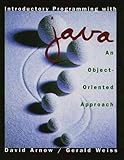Introduction to programming using Java : an object-oriented approach / David M. Arnow, Gerald Weiss.
Material type: TextPublication details: Reading, Mass. : Addison Wesley, c1998.Description: xxxi, 783 p. : ill. ; 23 cmISBN:
TextPublication details: Reading, Mass. : Addison Wesley, c1998.Description: xxxi, 783 p. : ill. ; 23 cmISBN: - 9780201311846
- Java
- 005.133 21
| Item type | Current library | Call number | Copy number | Status | Date due | Barcode | |
|---|---|---|---|---|---|---|---|
 Books
Books
|
Main library General Stacks | 005.133 / AR.I 1998 (Browse shelf(Opens below)) | 1 | Available | 004283 |
Browsing Main library shelves, Shelving location: General Stacks Close shelf browser (Hides shelf browser)

|

|

|

|

|

|

|
||
| 005.13 / SA.A 2008 Absolute C++ / | 005.13 / SE.C 1996 Concepts of programming languages / | 005.13 / SE.C 2010 Concepts of programming languages / | 005.133 / AR.I 1998 Introduction to programming using Java : | 005.133 / BA.E 2007 Embedded C programming and the Atmel AVR / | 005.133 / BA.E 2007 Embedded C programming and the Atmel AVR / | 005.133 BA.P 1998 Programming in Ada 95 / |
Includes index.
Chapter 1: Jumping Into Java Section -- Chapter 2: Using Objects Section -- Chapter 3: Using Classes Section -- Chapter 4: Defining Classes Section-- Chapter 5: The Class Design Process; Method Implementation and Numerical Processing Section -- Chapter 6: Controlling Behavior- Conditional Execution Section -- Chapter 7: Verifying Object Behavior Section 7.1: Introduction Section 7.2: Categories of Errors Section 7.3: Test Drivers Section 7.4: Automatic Testing Section 7.5: What to Test and How to Test It Section 7.6: Debugging Techniques Summary Study Aid: Terminology Review Questions for Review Further Exercises -- Chapter 8: Working with Multiple Objects Section-- Chapter 9: Iteration Section -- Chapter 10: Organizing Objects-- Chapter 11: Recursion Section-- Chapter 12: Examples-- Chapter 13: Extending Class Behavior-- Chapter 14: Exceptions -- Index.
Using the Java language, this book introduces the beginning computer science student to the concepts of class, object, and message in the first chapter. This object-oriented approach is used throughout the text, as students learn the fundamentals of object-oriented programming along with the basics of imperative programming. Because Java is an object-oriented language that reflects the acquired wisdom of thirty years of programming language design, the book can effectively focus on programming and the process of class design. Early on, a clear, usable procedure for solving problems by developing classes is presented and then used throughout the text. Java's support for GUI and network programming makes a great setting for diverse programming examples: a calculator, a strategy game, reading the Dow Jones from Yahoo!, a Web surveyor application, scheduling songs for a rock-and-roll radio station, as well as traditional payroll and student GPA computations. Working with these and other examples, students learn to think like a programmer, analyze problems, devise solutions, design classes, and write code. Features Uses object-oriented concepts from the very beginning--classes, objects, and messages are all introduced in Chapter 1--and develops them throughout. Applies a consistent class design procedure, usable by beginners. Contains graphic user interface (GUI) supplements in each chapter . Provides an early introduction to testing, covering test drivers, debugging, and test case selection. Includes a chapter with three robust applications--a LOGO turtle, a Web surveyor, and Mancala (a strategy game)--which use the text's class design procedure and allow the students to tie the material together.
This introductory programming in Java book offers a truly object-oriented approach, introducing objects and classes as early as the first chapter. The authors cover the important topic of recursion carefully and early, and place strong emphasis on the software development process, which allows readers to have some exposure to a real world topic. In addition, each chapter has a supplemental section that introduces graphic user interface (GUI) concepts through the medium of the Java AWT
1
There are no comments on this title.
